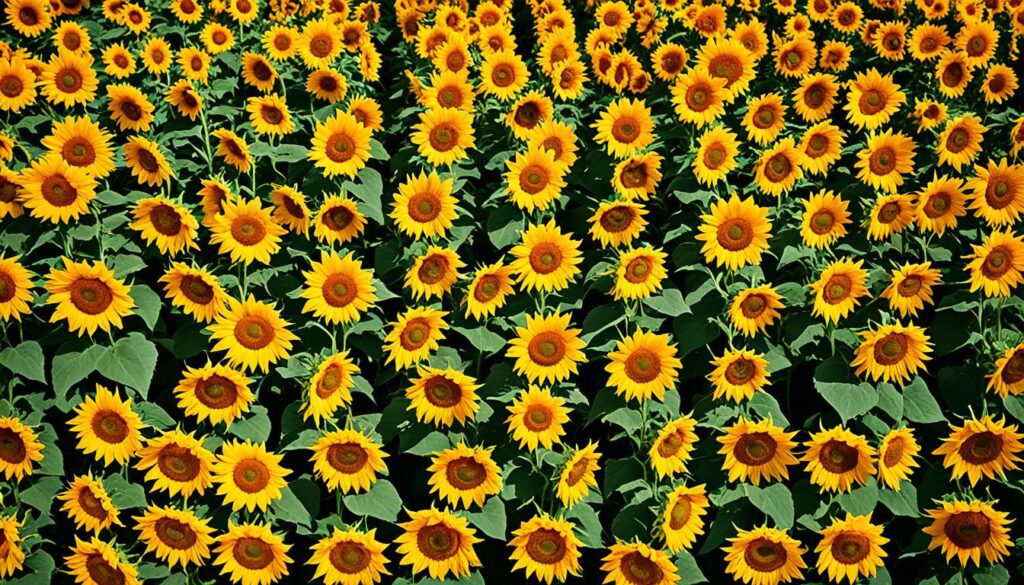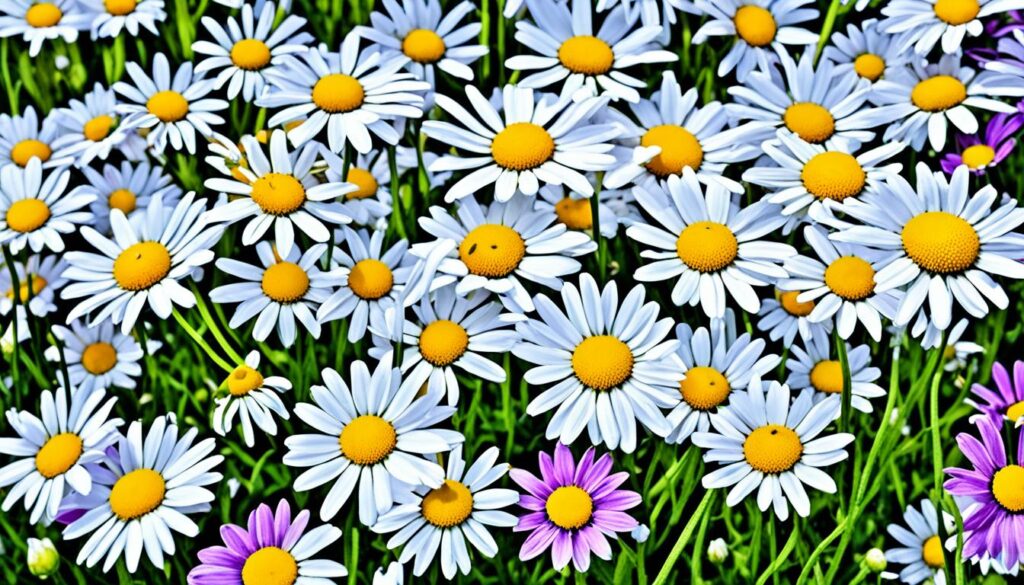
Did you know there are over 400,000 types of flowers in the world, each with its own unique characteristics? From the delicate rose varieties to the captivating lily species, the floral kingdom is a true wonder to behold. But have you ever wondered what makes these orchid types and tulip cultivars so special?
Or how sunflower types and daisy varieties can symbolize different emotions? Join us as we explore the carnation cultivars, chrysanthemum breeds, and peony hybrids that make up the captivating world of flowers.
Flowers come in thousands of different shapes and color combinations, each with their own name and classification. They bring us joy with their colors and scents, making them popular for all occasions. This article will dive into the captivating world of types of flowers, showing off nature’s diverse and stunning beauty.
Captivating World of Flowering Plants
Colorful flowers, varied scents, and interesting textures create a world beyond our own. In the field of botany, angiosperms, or flowering plants, stand out. The APG, an international team of botanists, works to find new angiosperms. This helps add to our knowledge of how plants are related, thanks to studies of their genes.
Diversity in Shape and Color
Flowers come in many shapes, sizes, and colors. They draw us in with their natural charm. A rose’s soft petals to a sunflower’s bright yellow – these are just a few examples. They show the wide variety of flowers in the world.
Angiosperms: The Flowering Plant Division
Angiosperms are the biggest and most varied group among flowering plants. They make up much of the plant life we see. Over millions of years, angiosperms have kept growing with new kinds of flowers. Botanists all over the globe keep finding and studying these flowering plants.
types of flowers
There are three main types of flowers: annual flowers, perennial flowers, and biennial flowers. Knowing each type’s unique traits can help you grow a beautiful garden. Each kind plays a role in making gardens vibrant and diverse.
Annuals, Perennials, and Biennials
Annual flowers live their entire life in just one season. These include zinnias, marigolds, and petunias. They bring bursts of color in the warmer months. However, perennial flowers come back each year. They die in winter but bloom again in spring. Known perennials are daylilies, peonies, and irises. Biennials need two years to grow, showing foliage the first year and flowers the next.
Shrub Flowers and Tree Flowers
Shrub flowers and tree flowers are also important. Shrub flowers grow on plants with woody stems, like hydrangeas and crape myrtles. Tree flowers blossom on trees, such as dogwoods and magnolias. Mixing these types in a garden can make it beautiful and full of variety.
Rose Varieties: A Colorful History
The story of the rose is full of color. Roses have been growing for over 35 million years. However, people started to grow them themselves about 5,000 years ago. These flowers were not only beautiful but also had many uses. They helped in medicine, making perfumes, and even as confetti for celebrations.
Origins and Cultivation
The rose varieties we enjoy come from ancient times. Every culture had its own special rose varieties which have evolved over time. This evolution has given us roses of different colors, shapes, and scents. You might love the classic red or prefer the softer pastels. This variety makes the rose history and its cultivation so interesting.
Care and Maintenance
Maintaining your roses well is important for their health. Like us, they need water to live. When you pick some, put them in cool, clean water right away. This allows the roses to drink and keeps them looking fresh. Remember to check the water level often and top it up as needed.
Sunflowers: Symbols of Adoration and Bounty
Sunflowers are a favorite with their vibrant yellow petals and large size. They stand for adoration, loyalty, and long life. To Native Americans, sunflowers mean harvest and bounty. This is because they provide seeds, pigments, and are beautiful.
Sunflower cultivation needs a lot of direct sunlight. They thrive in hot weather. Sunflowers have deep roots. So, they need room in loose soil. Careful not to over-fertilize, it might make the stems weak. They’re not just for show; they make lovely gifts and bouquets too.
| Sunflower Care Tips | Recommendations |
|---|---|
| Sunlight Needs | 6-8 hours of direct sunlight per day |
| Soil Requirements | Well-drained, not too dense |
| Fertilization | Avoid over-fertilization |
| Gifting and Bouquets | Excellent for both |

Hydrangeas: Stunning Garden Ornamentals
You know summer is here when big, showy hydrangea bushes start to appear in gardens. They grow in East Asia and the Americas. There are over 75 species and 600 vines of hydrangeas. You’ll find types like mophead, lacecap, oakleaf, and peegee. The color of the flowers can change to pink or blue based on the soil’s pH. Some stay white too.
Mophead, Lacecap, and Other Varieties
Mopheads, lacecaps, and oakleafs flower on last year’s stems. They should be pruned in summer once they bloom. Peegees flower on this year’s new growth, so you should prune them in late winter. This way, your garden will be full of various colors and shapes of hydrangeas.
Soil and Pruning Requirements
Hydrangeas need special care to grow well. They like soil that’s moist and drains well. The way you prune them depends on their type. Knowing how to take care of each kind is vital for a beautiful hydrangea garden all season.
Lavender: Fragrant and Soothing
Lavender plants come in many types, like Spanish, French, or English. They’re favorites in herb gardens. They offer soothing scents and taste, wrapped up in lovely flowers. There are over 40 kinds of lavender varieties, mostly from the Mediterranean. These plants have gray-green, fuzzy leaves and pretty flowers ranging from purple to white.
The tiny glands on lavender produce a scented oil. This oil is used in many products. You can find it in perfumes, bath items, aromatherapy to help relax or soothe, and lavender water. Lavender is also a great addition to food and drinks. It’s used in cooking, teas, and to make special honey.
Culinary and Aromatherapy Uses
Lavender is more than just a nice smell. It’s been used in cooking and medicine for a long time. From making foods taste better to calming nerves, lavender is truly special. It’s a treasure in any garden.
Peonies: Late Spring Beauties
Peonies are well-loved flowers that bloom in late spring or early summer. They come in many types, from white to red, and purple. Planting them right and caring for them is key to their success. This is important all year, even when they are not blooming.
Planting and Care Tips
Peonies can grow up to 5 feet tall, so pick a large spot for them. They return each year, so think ahead when planting and caring for them. They need well-drained soil and a lot of sunlight for the best growth.
Daisies: Innocence and Diversity
Daisies are loved everywhere except Antarctica. They are part of a big plant family. They stand for innocence, a Victorian symbol. The daisy varieties change the flower’s meaning with their colors.
Color Symbolism
The color of a daisy shows its message. White daisies mean purity and true love. Yellow daisies bring happiness and joy. Red daisies speak of beauty and love. Pink daisies show appreciation and softness.
Care and Maintenance
Daisy flowers like lots of sun and average soil. They can be short or quite tall. For good daisy care, water in summer when it’s dry.

Orchids: Ancient and Enchanting
Did you know orchids date back millions of years? Scientists think they first appeared 100 million years ago. There are over 30,000 orchid types, with some favorites being phalaenopsis and dendrobium.
Popular Orchid Types
Orchids carry deep meanings like love and charm. Each type has a special color and symbolism. For instance, phalaenopsis orchids stand for health and wealth. Dendrobium represents wisdom and beauty. Cymbidium showcases strength and nobility. Oncidium orchids signify love and talent.
Symbolic Meanings
Orchids have a long history filled with mystery and enchantment. They are loved worldwide for their beauty and care needs. Orchids’ stories and meanings vary in different cultures, yet they always inspire us with their endless charm.
Tulips: Harbingers of Spring
When tulips start to bloom, spring is here. These flowers belong to the lily family. There are more than 150 types, with a total of around 3,000 varieties. They come in many colors and shapes. Tulips were once so valuable that they were seen as more precious than gold in Holland. This was during a time called «Tulip Mania.» Today, the love for these flowers has only deepened over the years.
To enjoy tulips in the spring, plant their bulbs in the fall. They like places with sun. Make sure the soil can drain well. Tulips need to be watered carefully. Too much water can harm them. With the right care, these flowers will make your spring bright and colorful.
Tulips bring joy at Easter and hint at warmer weather. They have a special meaning and can make any garden look better. By knowing how to care for them, you can have beautiful tulips every year. This is a way to bring their beauty into your life again and again.



